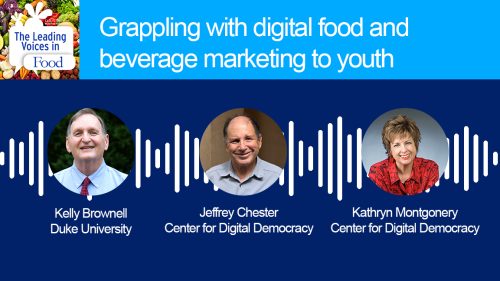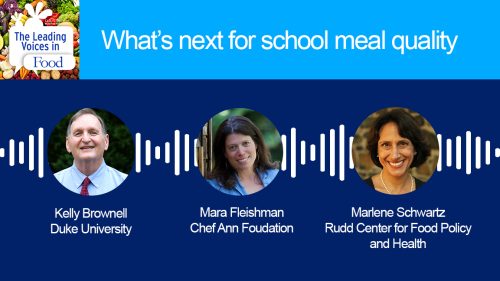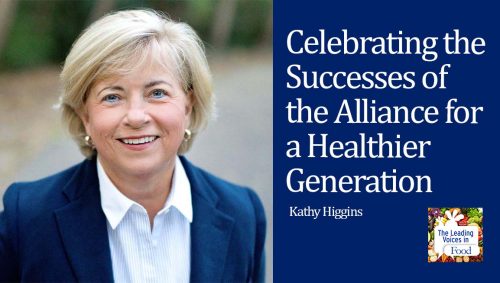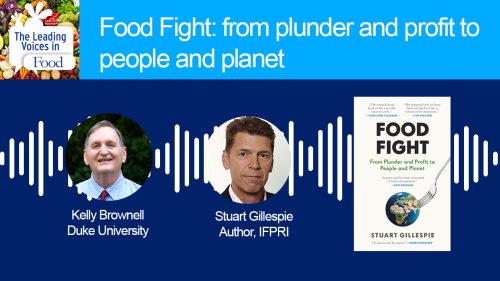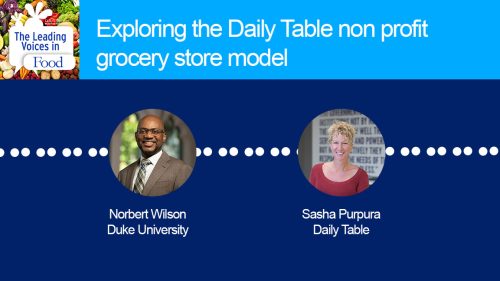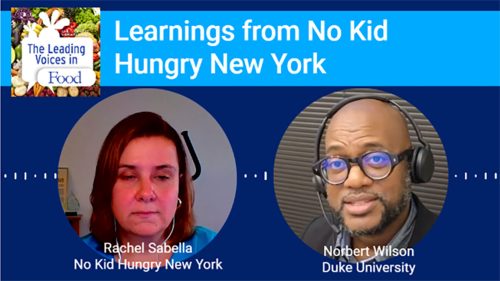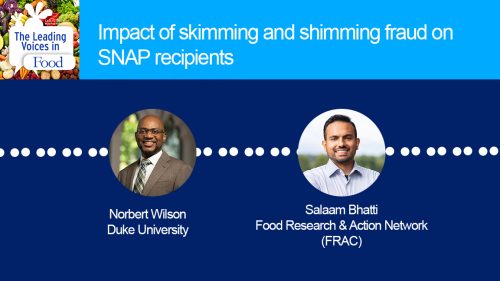E5: Kevin Concannon on the Role of Federal & State Food Assistance Programs
Imagine presiding over one of the nation’s major food assistance programs. The supplemental nutrition assistance program that helps feed more than $40 million Americans. And that this is just part of your job. Few people have seen the inner workings of federal and state food assistance programs as deeply as today’s guest, Kevin Concannon, former Undersecretary of Food, Nutrition and Consumer services in the US Department of Agriculture, under President Obama.
Subscribe: Apple Podcasts | TuneIN | YouTube Music | SoundCloud | PocketCasts | Radio Public
Tags: Advocacy & Food | Child Development & Nutrition | Childhood Obesity | Equity, Race & Food Justice | Food Policy | School Meals | Social Safety Net & Food |

In his time as Under Secretary, Kevin Concannon was responsible for funding and administering the Food and Nutrition Service and promoting healthy dietary guidelines through the Center for Nutrition Policy and Promotion. Working in partnership with state and local organization, he oversaw the Supplemental Nutrition Assistance Program known as SNAP (formerly known as the food stamp program), the child nutrition programs, including the national school lunch, school breakfast and summer food service programs, the Child and Adult Care Food (CACF) program, and the Supplemental Nutrition Program for Women, Infants, and Children (known as WIC) and more. Prior to his work at USDA, Kevin served as director of the State Health and Human Services Department in Maine, Oregon and Iowa. He has championed expanded services, improved access, alternatives to institutions, consumer choices, and affordable healthcare and diversity.
Interview Summary
Kevin, few people have had a career public service as you have. So on behalf of the nation, please accept my appreciation. And welcome to the show.
Thank you so much. I’m pleased to fill in with you here today. I have felt very fortunate over the years to have those responsibilities and as I reflect back on those times–that went by, frankly in retrospect, far too quickly–I’m pleased with what we were able to get accomplished.
Let’s talk about the impact of food assistance programs like SNAP and WIC. Are they effective? Are they cost effective?
Yes, they are on many, many fronts. Actually the, the food assistance programs, as you mentioned, serve more than $40 million people each day across the country. And people come on the program and go off over the course of the year so that there are actually in a calendar year there are millions more who benefit from the program. It not only provides the opportunity for individuals in households to access food in the US, but it also is one of the major components of the safety net, a frayed safety net, I would suggest, over the past decade or so if not longer. Where in the past, low income households in the across the US might have expected or been able to receive financial assistance in various forms, in many parts of the country that has disappeared. So by default, the SNAP program has become one of the major sources of household support for food that allows that household or individual then to use whatever other meager income they may have to spend that on housing or electricity or transportation and what have you.
Can you make an argument that for every dollar invested, the nation gets more than a dollar return?
Yes, actually, indeed. I know the Economic Research Service, a different mission area within the US Department of Agriculture, estimated that for each dollar expended by SNAP it creates between a $1.74 and a $1.80 by virtue of the multiplier effect. And some years ago, actually about five years ago, I sat in on a meeting at the Brookings Institution with major economists from around the country who were reflecting. The topic of that session was what worked in the last recession, that deep recession we had in 2009, 2010, 2011. And the opinion was unanimous that’s the most effective intervention in terms of mitigating some of that distress in individual households as well as in the broader economy was the success of the SNAP program. Because as you know, it’s very portable. The benefit distribution piggybacks onto the commercial electronic benefits systems. And it is portable in the sense that the program serves people in cities, in rural areas, in isolated parts of the country as well as in some of the most densely populated urban areas.
You alluded to this just a moment ago, but you became Under Secretary in 2009 just after very significant significant economic downturn. How did that impact your work and what was going on with these programs?
Well, you know, when I think back on my time as a federal employee in that role, I really, one appreciate, the importance of these various federal nutrition programs that were available to be deployed immediately. And fortunately, one of the first major acts that the Obama administration brought forth was one intended to mitigate or to mitigate the negative effects of the downturn and stimulate the economy. And additional benefits through the SNAP program resulted in a rather dramatic rise in enrollment, reflecting what was going on in American households. And I saw my particular role at that time is moving around and meeting with state officials, principally department heads in posts similar to what I had held in Iowa, Oregon, and Maine. So I had some familiarity with a discretionary role of state appointed leaders, not just the elected leaders. And I used that time period to both to press and to urge and to support state leaders who were availing themselves of options made available through federal policy to bring the program to individual households, individual communities across the country. And I think it really clearly had an impact. Again, not only individually but on the the respective economies of communities that were really being adversely affected by that downturn.
Let’s explore that a little further because there are differences across states and the percentage of people who are eligible for these benefits, who actually have them. That is due in part to customs across states and differences in leadership. Why is that the case that there are differences from state to state and the number of people who are enrolled?
You know, that’s one of the takeaways for me personally that I saw. I’d worked in three states, different states geographically, but at least at that point in their histories or when I was working there (not because of me, but because of the general political climate) these were I would say centrist states–centrist to the left of center–modestly, and the operating ethic in government at each of those states was to avail the state agency of options federally. What I learned during my federal years was that isn’t the case across the country. That was disappointing to me to see states, at times where there was great need, but where politically the ideology of the state or the lack of a real, what I would describe as authentic commitment on the part of state leaders appointed or elected, where they were really disinterested or not that concerned about the circumstances of their populations.
We measured states based on their poverty rates, and the rate of penetration, if you will, or engagement in the program. And I’m pleased to report that over time we increased the average participation based on estimated eligibility by double digits across the country. And we particularly focused on certain subpopulations that were underserved, including for example. People who are working part time often made the assumption–Gee, since I’m working, I won’t be eligible for a benefit. Well, yes, in fact, based on household size and income you might be. Seniors were another group. Latinos or Hispanics were another large subpopulation that were underserved. So we focused with states on those populations in particular and an urged states to take steps to reach out to those populations.
Some people may think that the differences from state to state are just economics. Some states don’t want to spend money and want to use it for other reasons, but that turns out not to be the case. Is that right?
That’s exactly it. The irony is that the benefits that are provided through the SNAP program are 100 percent federally paid. As is true of the WIC, the special program for women, infants and children focused on the population of very young children, infants and pregnant women or new moms. And in both of those instances, it does not require the state to spend money on the benefit. In the case of SNAP, the state is required to pay a portion of the administrative costs. But the administrative costs associated with SNAP are a single digit when compared to the benefit amount itself. And the case can be made that just from a pure economic benefit point of view, it benefits the state. So when, states across the country, or sometimes counties within states, are less inclined to support the program it more typically reflects their etiology or political culture rather than an honest assessment of the need.
What are some of the issues regarding incentivizing healthy foods and healthy eating within these programs?
Well, you know, some of the challenges, as you may know–the SNAP program allows persons to purchase any foods in the US for which basically the criterion is there is a barcode that can be associated with it, or if it’s sold in a store or in farmer’s markets. The only limitation is you cannot buy hot food. But even with that, there are a couple of states, California being one and Arizona a second, and then maybe a third Missouri, where the state elected to allow certain populations to use the benefit in restaurants. The underlying rationale for that was really to help either disabled persons or seniors living alone and/or homeless people, but by and large that has not been adopted across the country. Now, back to your question on incentivizing healthy foods. The closest we’ve come to that has been the expansion of access to farmers markets.
We went from, roughly in the beginning of the Obama administration, under a thousand farmers markets across the country that were authorized to process SNAP benefits to, at last count, in excessive of 7,000 farmers markets. There has been a very significant a pilot project in western Massachusetts that created a financial incentive for households to buy more fruits and vegetables that actually showed such incentives can work. And it was rigorously–it was a very expensive a project in terms of not so much the benefits as much as the evaluation, but it showed that you can incent people in certain directions. And I actually had some discussions with people in New York State, in New York City, that never came to fruition because we never quite settled on a subpopulation within New York City to both put some either voluntary or mandatory limits on purchasing of certain foods, like sugar-sweetened beverages as an example, and coupling this with some additional either purchasing benefits for the households that would participate in such. We never really got to settle on that. And I have resisted–the state of Maine, my own native state actually, submitted a request to put limitations on SNAP purchases. But there was no rigorous evaluation with it and frankly I personally couldn’t–I couldn’t overlook the fact that the state itself had basically a gutted it’s public health programs during that particular administration. So it really did not on other fronts have much of a record of saying we’re genuinely interested in trying to effect for the better the health of the populations. But we didn’t outright said you can’t do this. We said you have to resubmit it with a stronger evaluation. And of course I’m no longer there. So I don’t know what the status of that is.
So these programs have been around for many years. How do they fare under different political leaderships in DC?
Well, it’s interesting this very week as we’re recording this a podcast, we expect within days the so-called Farm Bill of 2018 to be released. A House version was passed earlier this year that had what I would consider a number of a punitive elements in it as it pertained to the snap program around work requirements and any other restrictions. Happily, from my point of view, the Senate has more bipartisanship, at least on the Farm Bill issues, in the it has from the outset–the leadership of the committee has said they’re not interested in, moving forward with those elements in the recognition that it would probably kill a bill in the Senate period. So, the politics of the Farm Bill are really important for one, the funding of the program, but also the authorizing of the policy elements in it.
And, I’m enthusiastic about the changes that are forthcoming, or will be forthcoming when the new house is seated in January because, we clearly see more of a both a recognition among the members on the house side of the importance of the program. But more of a desire to say, how can we constructively address issues of food insecurity or folks just eating by virtue of where they live, not having access to healthier foods consistently. And programs like school meals this, this past week, actually just within the last couple of days, the current administration at USDA finalized federal regulations that will allow schools, if they so choose across the country, to weaken the nutritional values in the school meals program. This would be by allowing schools to delay their adherence, if you will, or meeting standards to lower sodium in the foods that are consumed, to not be as required to meet a new or existing standards for whole grains, and to reintroduce a higher fat content in the sugar-sweetened milks that are currently served in schools.
A compromise was reached some years ago on allowing schools–for milk consumption–to continue to serve if they so chose, a flavored milk. But the requirement was, one, the sugar content can’t be over a certain number of milligrams. Nor can there be a fat content above the nonfat level. Well the current administration has basically said we’re not interested in sticking with that. And I think that’s really unfortunate because it really shows to me the influence of industry. And it’s not, you know–professional nutritionists and dieticians are not the voices that are asking for these changes. It’s really coming from industry. And, I think regrettably so.
One of the issues that comes up sometimes in the discussion of the SNAP program is fraud. What are your thoughts on that?
Actually, ironically, I mean this used to be reflected here at USDA including Secretary Vilsack–would remark on this. We actually have a higher percentage of fraud in some of the major agriculture programs than we have in the SNAP program. But the actual percentage–there are two ways to measure fraud or misuse.
One would be for the benefit to go to households that really don’t qualify for it. Meaning their income is higher than would normally qualify them or they’re not reporting significant income. The percentage of fraud in that regard–it’s really more a payment errors, we would refer to it, because some of them are honest, honest mistakes–are in the single percentage. You know, they’re like 2%, 2.5% fraud in the sense. A more potent version of it, in my view, is where SNAP benefits are sold by store. A household comes in, or a low income person comes in with their benefits on an electronic card like a debit card almost. And the store recognizes that they may have $100 in benefits: says to the household, I’ll give you $50 in cash for that hundred dollar benefit and that percentage across the country is a little over 1%. So it’s a very low percentage, but it’s a troubling or worrisome percentage in the sense that people really latch onto what I’m talking about. People who are critical of needs based programs or safety net programs.
So, we worked hard to utilize more data analytics, more undercover folks, but with more data analytics, helped us identify a stores across the country that might be engaged in doing this. And they are kicked out of the program if they’re found doing this. Initially for a period of months, but then it can be a lifetime ban. And we stiffened those penalties during my time there. But it’s a very small percentage compared to almost any other type program. But again, one that, even at House hearings, particularly with House not so much the Senate. The House members, particularly more politically conservative members, would try to amplify or try to state, often without much evidence that they thought this was more widespread than it really is.
It is one of the most important aspects in terms of quality of life for people across the country these days. We didn’t get to talk much about the women, infants and children’s program by virtue of time limits, but as you probably recall WIC serves half of the births in the United States. One of the most important public health interventions we have. Because if you have healthy nutrition throughout pregnancy and good timely advice as a new parent–promoting as well the benefits of breastfeeding–you get better birth outcomes. And these better outcomes can extend over the life course. So again, a program not necessarily well known to the average person on the street, but pediatricians know it well. Obstetricians know well. And half the mothers and parents in the US would know it firsthand.


